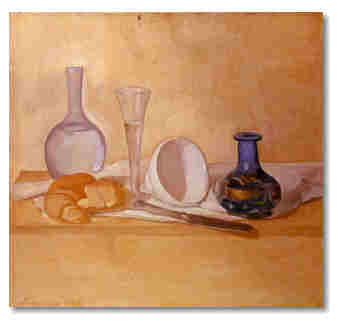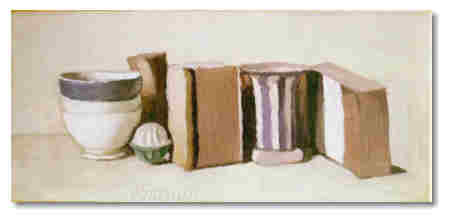



(1890-1964)
Morandi studied at the Academy of fine Arts in his native Bologna. He was associated with the Metaphysical School for a short time around 1918, and later with the Valorl' Plastici movement, which advocated a kind of neoclassical realism. From the mid-1920s to his death, however, Morandi remained an isolated artist whose muted still lres of such objects as bottles and pitchers generated a poetic response. His drawings, etchings, still life paintings, and occasional landscapes are often compared with those of Chardin and Cezanne in their architectonic harmony, hut a lyrical, softened, tonal atmospheric aura distinguishes them.
MORANDI'S THOUGHTS ON ART
"I have always avoided suggesting any
metaphysical implications. I suppose I remain, in that respect, a believer in Art for
Art's sake rather than in Art for the sake of religion, of social justice or of national
glory. Nothing is more alien to me than an art which sets out to serve other purposes than
those implied in the  work of art in itself...f believe
that nothing can be more abstract, more unreal, than what we actually see. We know that
all that we can see of the objective world, as human beings, never really exists as we see
and understand it. Matter exists, of course, but has no intrinsic meaning of its own, such
as the meanings that we attach to it. Only we can know that a cup is a cup, that a tree is
a tree."
work of art in itself...f believe
that nothing can be more abstract, more unreal, than what we actually see. We know that
all that we can see of the objective world, as human beings, never really exists as we see
and understand it. Matter exists, of course, but has no intrinsic meaning of its own, such
as the meanings that we attach to it. Only we can know that a cup is a cup, that a tree is
a tree."
[C. 1959]